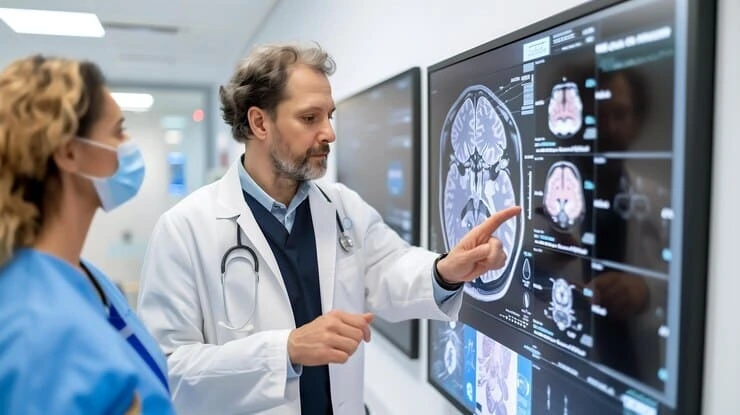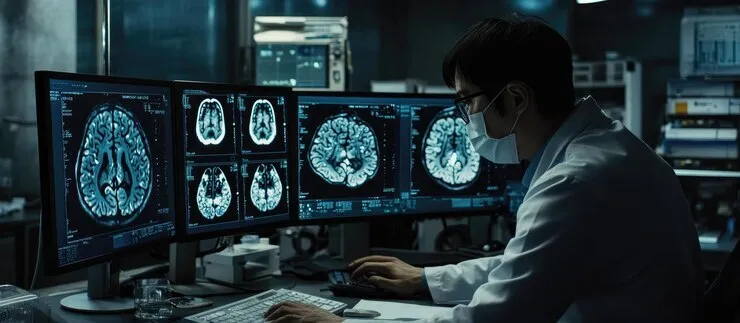Radiology stands at the forefront of medical innovation, constantly evolving with new imaging modalities and diagnostic capabilities. Yet, radiologists today face unprecedented challenges: an exponential growth in imaging volumes, increasing image complexity, and a global shortage of specialists. These pressures necessitate a paradigm shift in how medical images are processed, interpreted, and managed. Enter Artificial Intelligence (AI) a revolutionary force poised to fundamentally transform radiology, moving beyond theoretical hype to practical, intelligent imaging solutions that augment human capabilities and enhance patient care.
AI in radiology is not about replacing the human element; it's about empowering radiologists with sophisticated tools that can analyze vast datasets, identify subtle patterns, and automate repetitive tasks, thereby improving efficiency, accuracy, and overall workflow. This comprehensive guide will explore how AI is being put into action, driving a profound transformation in radiology through its intelligent capabilities.

The AI Imperative in Modern Radiology
The necessity for AI in radiology stems from a confluence of factors straining traditional workflows:
- Exploding Data Volumes:Advanced imaging techniques (e.g., multi slice CT, 3T MRI) generate thousands of images per study, leading to an information overload for radiologists.
- Increasing Complexity:Images are becoming more intricate, requiring highly specialized expertise for interpretation.
- Growing Workload & Burnout:Radiologists are stretched thin, facing pressure to read more studies faster, which can contribute to fatigue and potential diagnostic errors.
- Demand for Precision:The push towards personalized medicine requires ever more precise and quantitative diagnostic insights.
AI offers a viable path to address these challenges, acting as an indispensable assistant that enhances, rather than diminishes, the radiologist's role.
AI in Action Key Applications and Intelligent Imaging Solutions
The integration of AI is permeating various stages of the radiology workflow, from image acquisition to interpretation and reporting, creating truly intelligent imaging solutions.
- Preprocessing and Image Acquisition Drive Optimization
AI begins its work even before the radiologist views the image:
- Smart Protocoling:AI can optimize imaging protocols based on patient history, clinical indications, and real time scan parameters, reducing acquisition time and radiation dose while improving image quality.
- Artifact Reduction:AI algorithms can effectively identify and mitigate imaging artifacts (e.g., motion blur, noise, metal artifacts), leading to clearer, more diagnostically valuable images.
- Image Reconstruction:AI can accelerate image reconstruction from raw data, reducing scan times and improving image resolution, particularly beneficial for complex modalities like MRI.
- Enhanced Image Analysis and
Interpretation
This is arguably where AI's impact is most pronounced, serving as a powerful diagnostic aide within the DICOM viewer:
- Automated Anomaly Detection:AI algorithms can be trained to detect subtle abnormalities that might be missed by the human eye, such as small lung nodules on CT scans, intracranial hemorrhages on head CTs, or early signs of breast cancer on mammograms. These intelligent overlays or alerts can significantly improve detection rates and sensitivity.
- Precise Quantification:Manually measuring structures or pathologies is time consuming and prone to inter observer variability. AI excels at rapid, accurate quantification of features like tumor volume, organ size, lesion growth, or bone density, providing objective metrics crucial for treatment monitoring and prognosis.
- Disease Characterization:Beyond detection, AI can help characterize findings, differentiating between benign and malignant lesions based on complex patterns that are difficult for humans to discern consistently across large datasets. This is particularly valuable in oncology and neuroscience.
- Risk Stratification and Prediction:AI can analyze imaging data in conjunction with clinical information (e.g., EHR data) to predict disease progression, patient response to therapy, or even the likelihood of future events (e.g., cardiac events, stroke recurrence).
- Workflow Optimization and
Triage
AI streamlines the operational aspects of radiology, making processes more efficient:
- Intelligent Worklist Prioritization:AI can analyze incoming studies and prioritize critical cases (e.g., suspected stroke, pulmonary embolism) on the radiologist's worklist, ensuring that life threatening conditions are addressed first, potentially saving lives.
- Automated Reporting Assistance:AI can assist in generating structured reports by populating templates with automatically detected measurements and findings, reducing manual data entry and improving report consistency and speed.
- Quality Control & Completeness Checks:AI can automatically review studies for completeness, correct patient demographics, and identify suboptimal image quality, flagging issues before a study is finalized.
- Follow Up Management:AI can identify patients requiring follow up imaging based on current findings and remind clinicians, reducing missed appointments and improving patient management.
- AI Powered DICOM Viewers The
Integrated Intelligence
The most effective AI applications are those seamlessly integrated into the radiologist's daily workflow via their DICOM viewer. These are not separate tools but intelligent layers within the viewing environment:
- Intelligent Overlays:AI findings (e.g., detected nodules, hemorrhage outlines, segmented organs) are presented directly on the images within the viewer, allowing radiologists to quickly validate or dismiss them.
- Automated Measurements & Annotations:AI can perform initial measurements and suggest annotations, which the radiologist can then accept, modify, or reject, significantly speeding up reporting.
- Contextual Information:The viewer can pull relevant AI generated insights or risk scores directly into the viewing interface, providing radiologists with comprehensive context at a glance.
- Adaptive Workflows:The viewer can dynamically adjust its layout or display based on AI derived findings, optimizing the radiologist's reading experience for efficiency.
The Profound Benefits of Intelligent Imaging Solutions
The deployment of AI in radiology yields a multitude of benefits across the healthcare spectrum:
- Enhanced Diagnostic Accuracy:AI's ability to process vast amounts of data and identify subtle patterns can lead to earlier detection of diseases and a reduction in missed findings, ultimately improving diagnostic precision.
- Increased Efficiency and Throughput:Automation of repetitive tasks, intelligent worklist prioritization, and faster image analysis allow radiologists to read more studies in less time, increasing departmental throughput without compromising quality.
- Reduced Radiologist Burnout:By offloading tedious, high volume tasks, AI can alleviate cognitive load and reduce the risk of burnout for radiologists, allowing them to focus on the most complex and clinically challenging cases.
- Improved Patient Outcomes:Faster and more accurate diagnoses lead to earlier intervention, personalized treatment plans, and ultimately, better health outcomes for patients.
- Standardization and Consistency:AI algorithms provide consistent analysis, reducing inter observer variability in measurements and interpretations across different radiologists and institutions.
- New Insights and Research Opportunities:AI can uncover hidden patterns and correlations within large imaging datasets, paving the way for new discoveries, predictive models, and a deeper understanding of disease.
Challenges and Considerations for Adoption
While the promise of AI is vast, successful adoption requires addressing several key considerations:
- Data Quality and Bias:AI models are only as good as the data they are trained on. Ensuring diverse, high quality, and unbiased datasets is crucial.
- Regulatory Approval:AI algorithms intended for diagnostic use require rigorous validation and regulatory clearances (e.g., FDA approval in the US, CE Mark in Europe).
- Integration Complexities:Seamless integration of AI solutions into existing PACS, EHR, and DICOM viewer workflows is critical for real world utility.
- Radiologist Education and Acceptance:Radiologists need training to understand AI's capabilities, limitations, and how to effectively integrate AI insights into their diagnostic process. Trust in AI is built through transparency and proven performance.
- Ethical and Legal Implications:Addressing issues of accountability, algorithmic bias, data privacy, and the evolving role of the radiologist.
Choosing the Right AI Integrated Solution The Scriptoware Advantage
For healthcare organizations seeking to harness the power of AI in radiology, it is paramount to choose a solution that prioritizes security, compliance, and seamless integration. An AI solution, however intelligent, is only valuable if it can be reliably and securely deployed within existing clinical workflows.
Scriptoware understands this imperative. Our DICOM viewer and cloud based PACS system are designed with AI integration in mind, acting as a flexible and secure platform for deploying and leveraging intelligent imaging solutions. We focus on:
- Secure Infrastructure:Ensuring AI processing and data remain compliant with HIPAA, GDPR, and other regulations.
- Interoperability:Facilitating seamless data exchange between AI algorithms, the DICOM viewer, PACS, and EHR.
- Scalability:Providing the robust cloud infrastructure needed to handle the compute demands of AI and vast imaging datasets.
- User Centric Design:Integrating AI insights directly into the radiologist's workflow in an intuitive and actionable manner, enhancing rather than disrupting their reading experience.
Future Trends The Evolving Role of AI
The journey of AI in radiology is just beginning. Future trends include:
- Predictive Analytics:AI will increasingly predict patient outcomes and disease progression based on imaging and clinical data.
- Generative AI:Assisting in synthetic data generation for training, or even advanced report drafting.
- Personalized Medicine:AI tailoring diagnostic pathways and treatment recommendations to individual patient characteristics.
- Radiomics & Radiogenomics:Extracting vast amounts of quantitative data from images and correlating it with genetic information to uncover new biomarkers.
Conclusion
AI is no longer a futuristic concept but a tangible force actively transforming radiology. By integrating intelligent imaging solutions throughout the workflow, from acquisition to interpretation, healthcare providers can achieve unprecedented levels of diagnostic accuracy, efficiency, and patient safety. Embracing AI in action within a secure and integrated platform is essential for any radiology department looking to remain at the forefront of medical innovation and provide the highest quality of care.
Ready to leverage the power of AI to transform your radiology practice? [Contact Scriptoware today for a personalized demonstration of our AI integrated solutions!]
